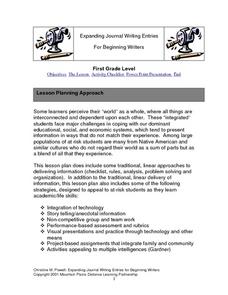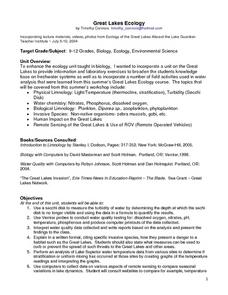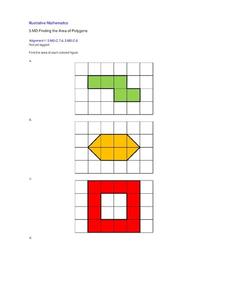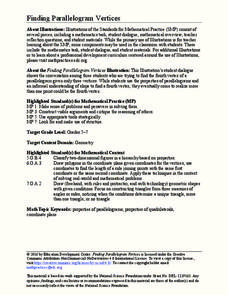Curated OER
Expanding Journal Writing Entries For Beginning Writers
First graders through a variety of strategies assess how to write in journals openly and effectively. Those strategies include integration of technology, story telling, group and team work, performance-based assessment/rubrics, visual...
Curated OER
Great Lakes Ecology
Eighth graders identify the Great Lakes, and describe the habitat of life of a loon. They are able to point to and explain one of the major river systems that enters the Great Lakes with a focus on the Clinton River and the food webs...
Curated OER
Vectors
Students are introduced to the bridge building challenge. They perform two labs and work in small groups to finish the vector worksheet. Students review vector additions. They then move onto the Forces on an Inclined Plane Lab. ...
Curated OER
Filling the Glass (Water, Air, and Fractions)
Students predict which of two glasses is 1/2 full using visual estimation, height measurement, and liquid measurement methods. Mathematical equations to accurately solve the problem are determined and verified.
Curated OER
Passive Integrator and Differentiator Circuits
In this circuits worksheet, students answer 25 questions about passive integrator circuits and passive differentiator circuits given schematics showing voltage. Students use calculus to solve the problems.
Curated OER
Symbols of the United States Alphabetical Order
In this American symbols instructional activity, students read 16 vocabulary words that pertain to the United States. Students alphabetize the words.
Curated OER
President Barack Obama Alphabetical Order Worksheet
In this online interactive President Obama activity, learners examine 16 words and names and then write them in alphabetical order on the lines provided. This activity may also be printed for classroom use.
Curated OER
Letter Combinations
In this letter combinations activity, students show all letter combinations of 3 letters given in each problem. Students solve 2 problems and answer 2 questions.
Curated OER
Lateral Thinking
For this lateral thinking puzzles worksheets, students use their problem solving skills to solve 10 word challenge puzzles revealing well-known words and phrases.
Curated OER
Teen Time
In this math crossword puzzle worksheet, students solve 9 addition fact problems and write the sums in the appropriate boxes to solve the crossword puzzle.
Curated OER
Subtraction Tree
In this math puzzle worksheet, students use their problem solving skills to respond to 6 questions that require them to use subtraction.
ABCya
Math Bingo
It's sometimes the simple games that really grab a learner's attention. With this game-like app, young mathematicians can practice addition, subtraction, multiplication, and division facts. When they reach new high scores, they collect...
Teach Engineering
Tell Me Doc—Will I Get Cancer?
Can you beat the odds of cancer? In the first installment of a seven-part series, future biomedical engineers consider how to detect and diagnose cancer. An article on biosensors provides useful information toward this goal.
University of North Carolina
Statistics
Let's see you back it up! As shown in the 18th handout in the Writing the Paper series of 24 lessons from UNC, statistics help form an effective argument. The handout discusses how to analyze a source and break down the data to ensure it...
EngageNY
Multiplying and Dividing Expressions with Radicals
That's radical! Simplifying radicals may not be exciting, but it is an important skill. A math lesson provides explanations of properties used throughout the material. Scholars practice skills needed to multiply and divide radical...
US National Library of Medicine
Science and Society: Preventing the Spread of Disease
Looking for a valuable resource on the spread of infectious diseases? Here is a lesson in which pupils simulate the spread of diseases and learn about how to prevent them from spreading. Class members read case studies about diseases,...
Utah Education Network (UEN)
Probability and Statistics
MAD about statistics? In the seventh chapter of an eight-part seventh-grade workbook series, learners develop probability models and use statistics to draw inferences. In addition, learners play games and conduct experiments to determine...
Charleston School District
Contextualizing Function Qualities
Let the graph tell the story! Adding context to graphs allows learners to analyze the key features of the function. They make conclusions about the situation based on the areas the graph is increasing, decreasing, or has a maximum or...
American Museum of Natural History
Trip Up Your Brain
Sometimes different parts of the brain disagree. See what this disagreement looks like using a remote learning resource to experience how brains often take shortcuts. Pupils complete the activity, observe their results, and then read...
Curated OER
Finding the Area of Polygons
Third graders are exposed to finding the area of polygons by decomposing figures and recomposing them into rectangles. This strategy allows children to expand on their prior knowledge of constructing shapes by rearranging parts into...
LABScI
Acoustics: The Sound Lab
If the delay between a sound and its echo is less than 1/10th of a second, the human ear can’t distinguish it. Through the use of a Slinky, rubber band guitar, and straws, scholars explore where sound comes from and how it travels. Whole...
Education Development Center
Finding Triangle Vertices
Where in the world (or at least in the coordinate plane) is the third vertex? Given two coordinate points for the vertices of a triangle, individuals find the location of the third vertex. They read an account of fictional...
Education Development Center
Finding Parallelogram Vertices
Four is the perfect number—if you're talking about parallelograms. Scholars determine a possible fourth vertex of a parallelogram in the coordinate plane given the coordinates of three vertices. They read a conversation...
NASA
Development of a Model: Analyzing Elemental Abundance
How do scientists identify which elements originate from meteorites? Scholars learn about a sample of material found in a remote location, analyzing the sample to determine if it might be from Earth or not. They study elements, isotopes,...

























